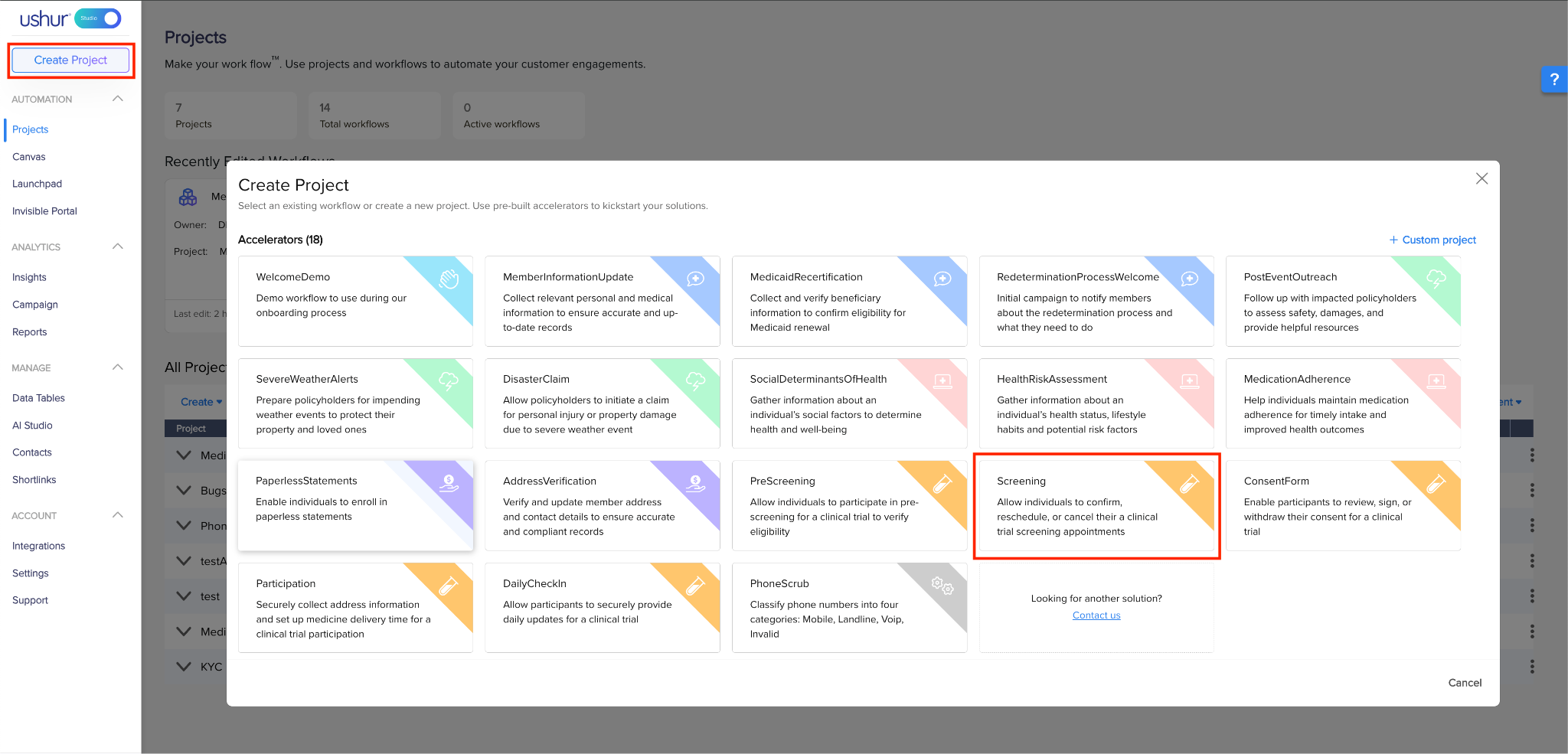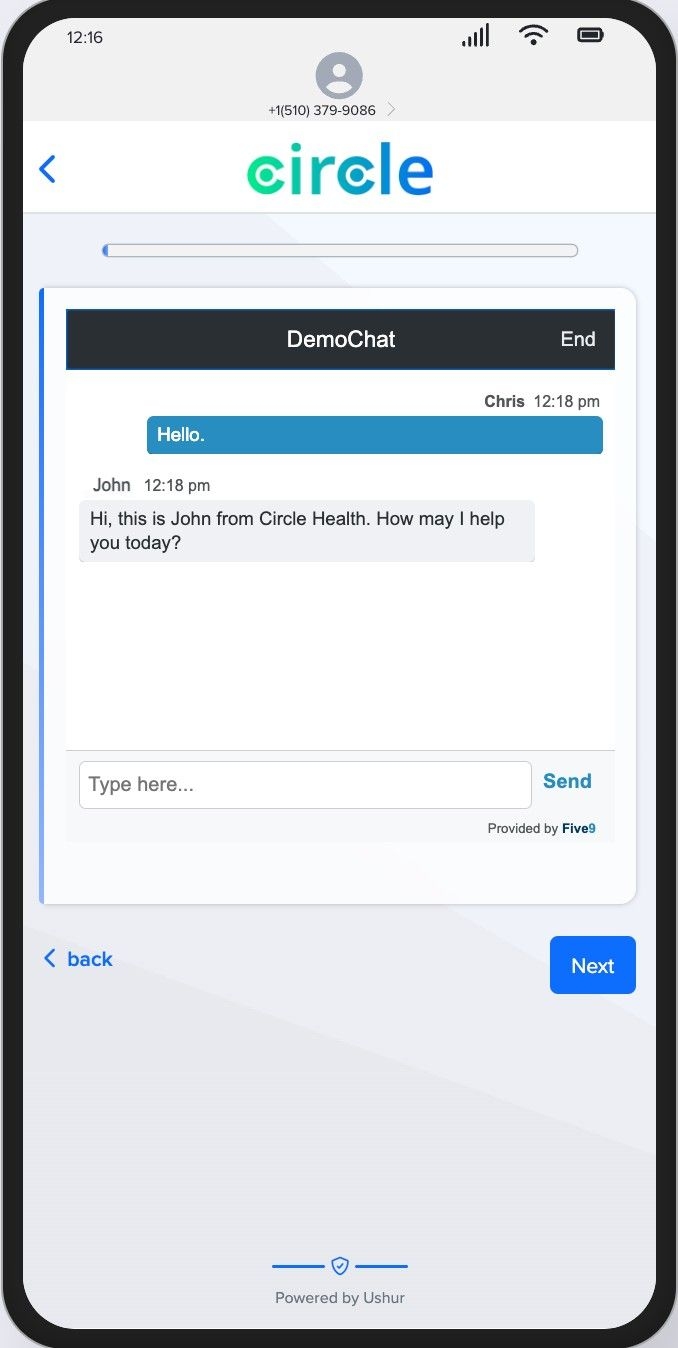- Print
- DarkLight
- PDF
Overview
The purpose of this accelerator is to streamline the clinical trial screening process for participants. Efficient management of clinical trials is essential for gathering accurate data, ensuring participant compliance, and regulatory standards. This accelerator eliminates the need for manual scheduling, repetitive paperwork, and constant phone calls, reducing administrative burdens. This accelerator ensures a smooth and efficient process by automating the screening, scheduling and management of clinical trial activities.
Below is a step-by-step guide to securely manage the clinical trial screening process through the Ushur Invisible App.
Accelerator Navigation
Navigate to Create Project > Screening.

The Workflow

To configure the workflow settings refer to Configure the Setup and Start Option.
Description Of The Steps
Step Name | Description/Functionality |
|---|---|
Welcome! | First engagement with the end-user with a welcome message stating the purpose of the engagement and providing a link to the Ushur Invisible App. |
AppointmentConfirmation | End-user chooses to confirm, reschedule, or cancel their screening appointment. |
RescheduleAppointment | End-user selects a new date and time for their screening appointment. |
ConfirmAppointment | Confirmation of the end-user’s screening appointment details and asking the end-user if they want an email confirmation. |
EmailConfirmation | End-user update their email address if necessary and then send the end-user an email confirmation of their screening appointment. |
ThankYou | Last engagement with the end-user and launch the ‘ConsentForm’ workflow for the next step.
|
Pre-Defined Tags Configuration
To Configure the pre-defined tags, navigate to Setup & Start > Data.

Tag Name | Tag Description |
|---|---|
AppointmentStatus | The status of the end-user’s screening appointment (Note: Stores the either of the value ‘Confirm’, ‘Reschedule’, or ‘Cancel’). |
CompanyName | Name of the company conducting the clinical trial. |
CompanyNumber | Phone Number of the company conducting the clinical trial. |
ConfirmationReplyEmailAddress | Email address to be used to reply to the screening appointment confirmation email. |
ConfirmationSenderEmailAddress | Email address to be used to send the screening appointment confirmation email. |
EmailSubject | Subject of the screening appointment confirmation email. |
LabName | Name of the lab conducting the clinical trial. |
PatientEmailAddress | Email address of the end-user. |
PatientFirstName | First name of the end-user. |
PatientLastName | Last name of the end-user. |
PatientPhoneNumber | Phone number of the end-user. |
ScreeningAppointmentDateTime | Timestamp of the clinical trial screening appointment of the end-user. |
Additional Enhancement Suggestions
Add reminders
You can remind the end-user to finish incomplete engagements through Enable Reminders. Refer to General Tab.
Add MFA (Multi-factor authentication)
Enable OTP-based multi-factor authentication for the Invisible App. Refer to Invisible App Tab.
Add Call an Agent capability
The end-user can have the option to call the medication company representative or the lab representative and connect with them for instant support. Refer to Phone Agent Module.
Create a Calendar Invite
The end-user can receive an invite.ics file for the invite so they can easily add the screening appointment to their calendar. Refer to File Creation Module.
Integrate third party chat capability
You can integrate a third party chat like Five9 in the Invisible App experience. Contact your CSM to know more. Below is a reference:

Data Integration
Data Table is the data from the Enterprise that Ushur utilizes within the workflow and then exports it back to the Enterprise. For more information refer to Data Tables.
|
|
Import Data Module
The Import Data module helps you to integrate the data table records into the workflow tags. You can use the tags to display data or ask the end-user to update the value of the tags. To integrate the data table records into tags, follow the below steps:
Drag and drop or double-click the Import Data module into the Inspector Panel of the Welcome Step and double click to configure it.
From the Datatable to link dropdown select the data table from which you want to import data.
Choose the Unique key of your data table and select the record to link the key value from the respective dropdowns.
Select the next step to be executed from the On Error Branch to dropdown in case an error occurs while fetching the data.
Select the checkbox named Copy Data From and map your data table properties to the respective tags.
Select the tag from Save To dropdown. The tag descriptions are described above in the Tag Description Table.
You can also store the data table properties into new tags, scroll down to the bottom of Save To dropdown to find the New Tag button.
Export Data Module
The Export Data module helps you to store the information of the tags into the data table or a predefined SFTP server. To export the values the tags into the data table:
Drag and drop or double-click the Export Data module into the Inspector Panel of the Thank You Step and double click to configure it.
Under Export to choose your export destination as Datatable.
Select the data table you want to export data to from the Export to Datatable dropdown.
Select a destination datatable column from the Export to dropdown for all the tags whose data you want to export.
An Example Of Setting Up The Data Table
Add the properties to the data table.

Data in the Data Table before executing the workflow.

Data in the Data Table after executing the workflow.





